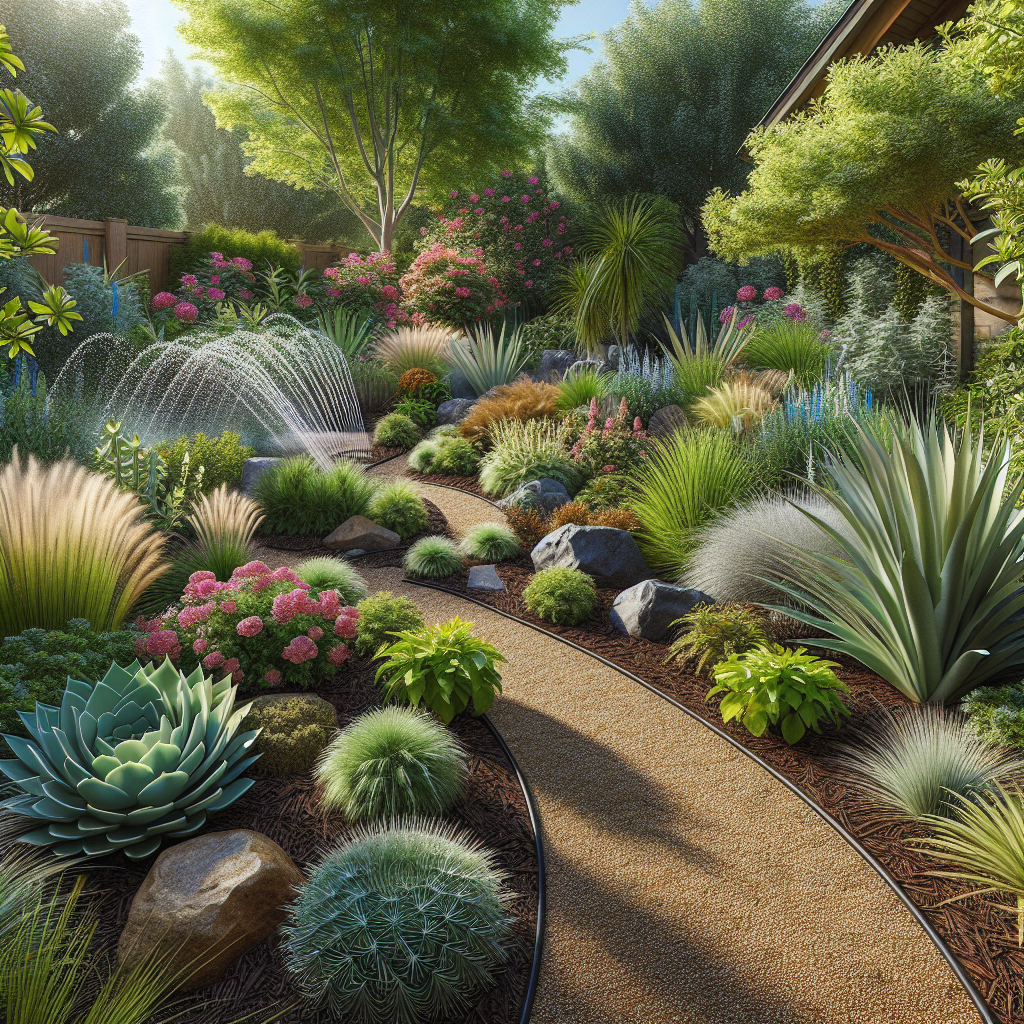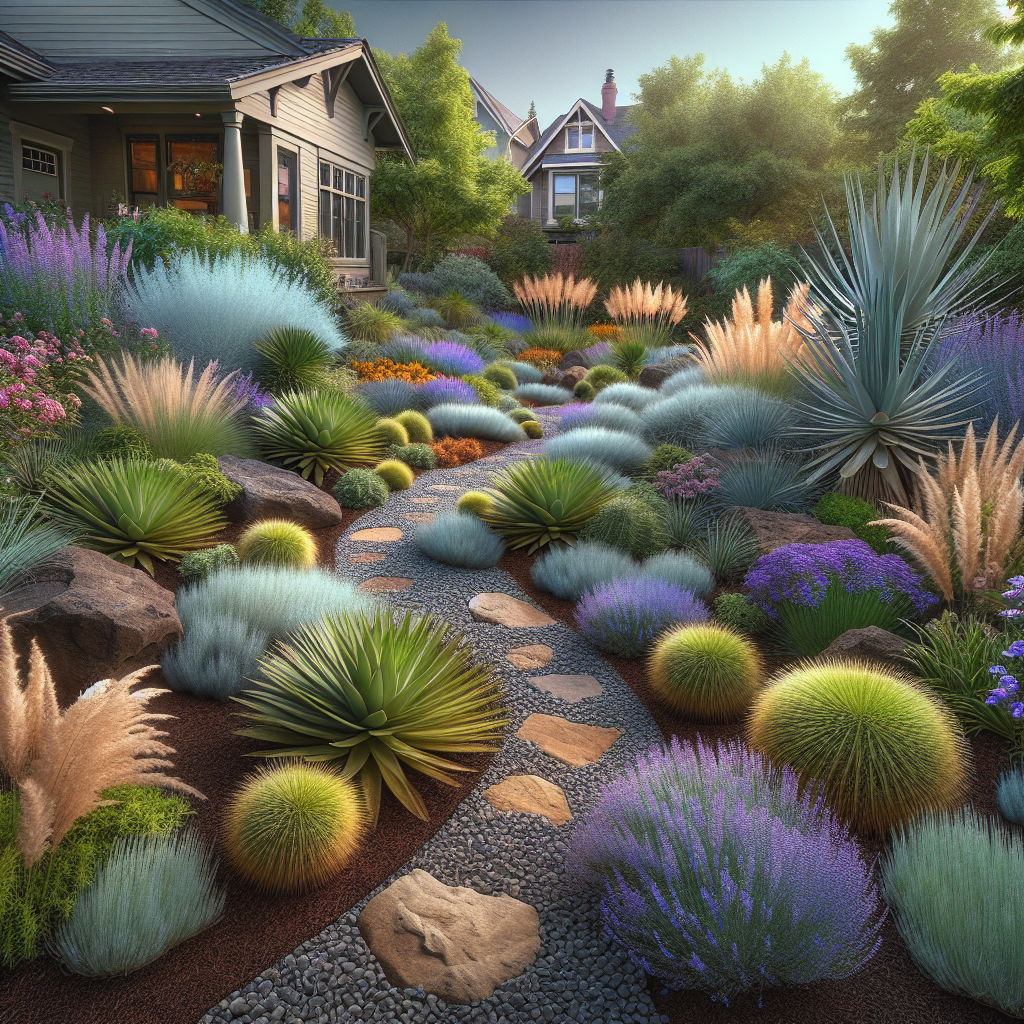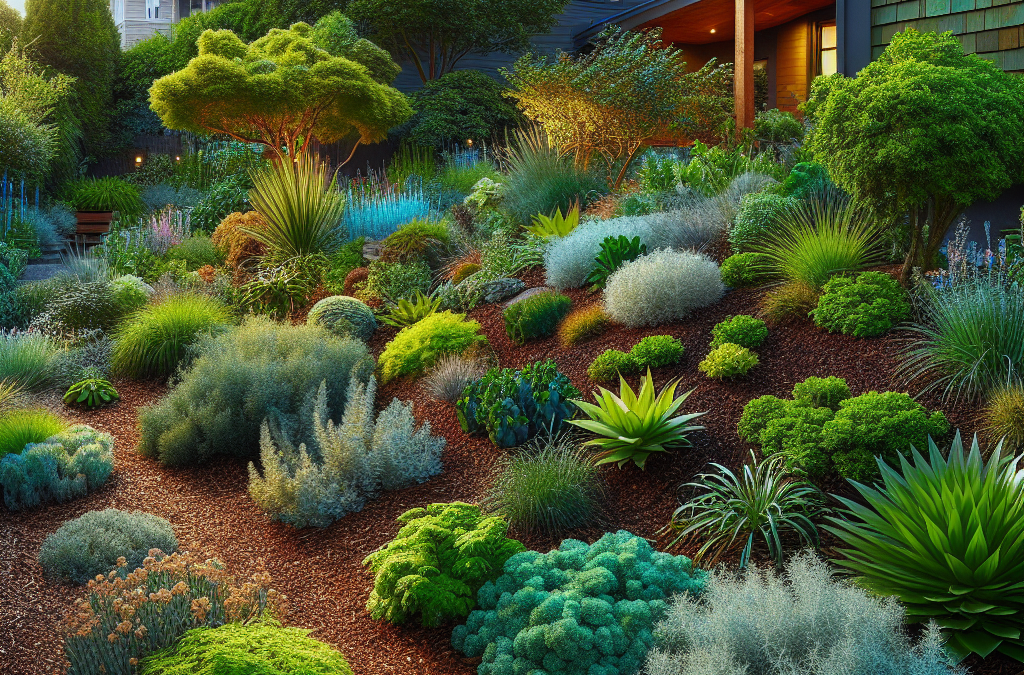Welcome to the world of Portland Xeriscape Landscaping, where water conservation meets aesthetic brilliance. As urban areas grapple with water scarcity and environmental changes, xeriscaping emerges as a sustainable landscaping solution. This approach not only addresses the need for water efficiency but also promotes eco-friendly practices that can transform your yard into a lush, green haven.
Xeriscape landscaping, derived from the Greek word ‘xeros’ meaning dry, involves designing landscapes to reduce or eliminate the need for supplemental water from irrigation. In Portland, where rainfall patterns can be unpredictable, adopting xeriscape techniques can lead to significant water savings and a more resilient garden.
By incorporating native plants, improving soil quality, and utilizing efficient irrigation systems, xeriscape landscaping creates visually appealing and low-maintenance outdoor spaces. These practices are not just beneficial for the environment but also help homeowners save on water bills and reduce their overall maintenance efforts.
Contact us today to discover how our landscaping services can transform your property! https://yardservicepdx.com
Benefits of Xeriscape Landscaping

Embracing xeriscape landscaping in Portland offers a multitude of benefits that extend beyond water conservation. One of the most significant advantages is the substantial reduction in water usage. By selecting drought-tolerant plants and employing efficient irrigation techniques, homeowners can drastically cut their water consumption, contributing to both environmental sustainability and cost savings.
Another key benefit is the decrease in maintenance requirements. Traditional lawns and gardens often demand frequent watering, mowing, and fertilizing. In contrast, xeriscaped landscapes are designed to thrive with minimal intervention. This means less time spent on yard work and more time enjoying your outdoor space.
Xeriscape landscaping also promotes biodiversity by encouraging the use of native plants. These plants are naturally adapted to the local climate and soil conditions, making them more resilient to pests and diseases. Additionally, native plants provide essential habitats for local wildlife, fostering a healthier ecosystem.
Furthermore, xeriscaping enhances the aesthetic appeal of your property. With a diverse selection of plants, textures, and colors, you can create a unique and visually stunning landscape that stands out in your neighborhood. The thoughtful design and natural beauty of xeriscaped gardens can also boost your property value.
Lastly, by reducing the need for chemical fertilizers and pesticides, xeriscape landscaping contributes to healthier soil and cleaner water sources. This eco-friendly approach not only benefits your immediate environment but also supports broader conservation efforts.
Choosing the Right Xeriscape Plants
Selecting the appropriate plants is crucial for a successful Portland xeriscape landscaping project. The goal is to choose species that are not only aesthetically pleasing but also well-suited to the local climate and soil conditions. Native plants are often the best choice as they have evolved to thrive in the region’s specific environment, requiring less water and maintenance.
Start by considering plants like Oregon Grape and Red Flowering Currant. These native species are known for their drought tolerance and can add vibrant colors to your landscape. Another excellent option is the Sword Fern, which provides lush greenery and can withstand dry conditions once established.
If you’re looking for ground cover, Kinnikinnick is an ideal choice. This hardy plant spreads easily and requires minimal water, making it perfect for xeriscaping. For a touch of elegance, consider incorporating Lavender. Its fragrant blooms and silvery foliage not only beautify the garden but also attract pollinators like bees and butterflies.
Incorporating ornamental grasses such as Blue Fescue and Feather Reed Grass can add texture and movement to your landscape. These grasses are drought-resistant and can thrive in full sun, making them low-maintenance additions to your garden.
Finally, don’t overlook the importance of trees and shrubs in xeriscape design. Species such as the Pacific Madrone and Serviceberry are excellent choices. They provide shade, reduce soil erosion, and support the local ecosystem.
By carefully selecting a mix of these plants, you can create a beautiful, sustainable landscape that conserves water and requires minimal upkeep.
Design Principles for Xeriscape Gardens

Effective design principles are essential for creating a thriving Portland xeriscape landscaping garden. These principles ensure that your garden not only conserves water but also remains visually appealing and functional throughout the year.
1. Planning and Design: Begin with a comprehensive plan that outlines your garden’s layout. Consider the natural slope of your land and group plants with similar water needs together. This zoning approach helps to maximize water efficiency and ensures that each plant receives the appropriate amount of moisture.
2. Soil Improvement: Enhance your soil’s ability to retain moisture by adding organic matter such as compost. Well-amended soil not only supports plant health but also reduces the need for frequent watering.
3. Practical Turf Areas: Limit the use of traditional turf grass, which typically requires a lot of water. Instead, design practical turf areas that are functional and easy to maintain. Consider using drought-tolerant grass varieties or alternative ground covers like ornamental grasses and low-growing perennials.
4. Efficient Irrigation: Implement an efficient irrigation system, such as drip irrigation or soaker hoses, which deliver water directly to the root zone of plants. This minimizes water loss due to evaporation and runoff. Additionally, consider installing a smart irrigation controller that adjusts watering schedules based on weather conditions.
5. Mulching: Apply a layer of mulch around your plants to help retain soil moisture, suppress weeds, and regulate soil temperature. Organic mulches like wood chips, straw, or compost are excellent choices as they decompose and enrich the soil over time.
6. Use of Hardscapes: Incorporate hardscape elements such as gravel paths, stone patios, and decorative rock features. These not only add visual interest but also reduce the amount of water needed for plant life. Hardscapes can also help manage stormwater runoff and prevent soil erosion.
By adhering to these design principles, you can create a sustainable and beautiful xeriscape garden that thrives with minimal water usage while enhancing the overall aesthetic of your property.
Water Conservation Techniques in Xeriscaping

Implementing effective water conservation techniques is a cornerstone of successful Portland xeriscape landscaping. These methods not only help in reducing water usage but also contribute to the health and sustainability of your garden.
1. Drip Irrigation Systems: One of the most efficient ways to water your xeriscape garden is by using drip irrigation systems. These systems deliver water directly to the base of plants, ensuring that moisture reaches the root zone without being lost to evaporation or runoff. This targeted approach can significantly reduce water usage compared to traditional sprinkler systems.
2. Rainwater Harvesting: Collecting and utilizing rainwater is an excellent way to conserve potable water. Install rain barrels or larger cisterns to capture runoff from your roof. This harvested water can be used to irrigate your garden during dry periods, providing a sustainable and cost-effective irrigation solution.
3. Soil Moisture Sensors: Utilize soil moisture sensors to monitor the moisture levels in your garden. These sensors can help you determine when your plants truly need water, preventing overwatering and ensuring that each plant receives the right amount of moisture. Many modern sensor systems can be integrated with smart irrigation controllers for automated, precise watering.
4. Mulching: Applying a thick layer of mulch around plants is one of the simplest yet most effective water conservation techniques. Mulch helps retain soil moisture, suppresses weeds, and moderates soil temperature. Organic mulches like wood chips, straw, and compost are particularly beneficial as they decompose and improve soil health over time.
5. Drought-Tolerant Plants: Choosing drought-tolerant and native plants is fundamental to xeriscaping. These plants are adapted to local climate conditions and require less water once established. Popular choices for Portland xeriscape landscaping include lavender, yarrow, and various sedum species.
6. Greywater Systems: Consider installing a greywater system that recycles water from household activities such as laundry, dishwashing, and bathing. This greywater can be treated and used for irrigating your garden, reducing the demand on municipal water supplies and promoting sustainability.
By incorporating these water conservation techniques, you can create a resilient and eco-friendly xeriscape garden that thrives with minimal water input, contributing to a greener and more sustainable environment.
Maintaining Your Xeriscape Landscape

Maintaining a xeriscape landscape involves a few unique practices compared to traditional gardening, but the results are well worth the effort. Here are some essential tips to ensure your Portland xeriscape landscaping remains vibrant and healthy year-round.
1. Regular Inspections: Conduct regular inspections of your xeriscape garden to identify any issues such as pest infestations, plant diseases, or irrigation system malfunctions. Early detection and intervention can prevent minor problems from becoming major headaches.
2. Pruning and Trimming: Routine pruning and trimming are crucial for maintaining the shape and health of your plants. Remove dead or diseased branches, and trim back overgrown areas to promote better air circulation and sunlight penetration, which can enhance plant growth and reduce the risk of disease.
3. Weed Control: Weeds can compete with your xeriscape plants for water and nutrients. Implement effective weed control measures such as mulching and manual weeding to keep unwanted plants at bay. Mulch not only suppresses weeds but also helps retain soil moisture.
4. Soil Health: Maintaining healthy soil is key to a thriving xeriscape garden. Periodically test your soil to ensure it has the right pH levels and nutrient content. Add organic matter such as compost to improve soil structure and fertility, fostering a robust root system for your plants.
5. Irrigation System Maintenance: Check your drip irrigation system regularly to ensure it is functioning correctly. Look for clogged emitters, leaks, or damaged tubing, and make necessary repairs promptly. Properly maintained irrigation systems optimize water usage and ensure that plants receive adequate hydration.
6. Seasonal Adjustments: Adjust your maintenance routines according to seasonal changes. During the hot summer months, monitor soil moisture levels more frequently and provide additional watering if needed. In contrast, reduce watering during the cooler, wetter months to prevent overwatering and root rot.
By adhering to these maintenance practices, you can enjoy a beautiful, low-maintenance xeriscape garden that conserves water and supports ecological balance. Contact us today to discover how our landscaping services can transform your property!

